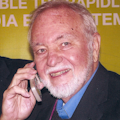Ultra wideband (UWB), the short-range wireless technology that offers the highest potential data rate of any other wireless technology (>110 Mbits/s with a 10-meter range), continues to gestate as various companies squabble and jockey for position during the standards development process. The outcome will be an IEEE standard known as 802.15.3a.
Dozens of companies are participating in the standards process, which like most IEEE processes is torturous and contentious. Long-time UWB developers are vying with the newer, big money companies to get their technical standard accepted, or at least some part of it. At stake are big bucks tied to patents, intellectual property, and bragging rights. So what's the latest?
The IEEE 802.15.3a standards group met in December in Vancouver to decide between the specifications put forth by the Multiband OFDM Alliance (MBOA) and the standards backed by Motorola/XtremeSpectrum. The MBOA proposal is winning with a 61/39 vote, but a 75/25 or better percentage is required for final ratification as an IEEE standard. So it's back to the drawing boards, negotiations, and behind-the-scenes machinations.
Most of those pursuing UWB support the MBOA's most recent specifications. All of the big semiconductor companies, like Intel, Texas Instruments, and over 60 others, support MBOA. The holdout is Motorola, which recently acquired XtremeSpectrum, a startup that had beaten everyone else to market with real chips.
The XtremeSpectrum Trinity chip set was already being sampled and tested when the MBOA initiative came along. The XtremeSpectrum system uses traditional impulse UWB with binary phase-shift keying and a CDMA encoding scheme for multiplexing and channelization. The MBOA approach employs the more complex orthogonal frequency-division multiplexing method, yet it offers greater flexibility in adjusting the spectrum coverage to local needs and speeds. While the MBOA scheme is by far the most complex, the use of DSP to handle all of the fast Fourier transform (FFT) and inverse FFT processing is a relatively easy way to go.
Because of the gridlock in the IEEE Task Group, the frustrated MBOA group is moving ahead with its own specifications. The 1.0 version of the spec is scheduled for release in May. Because the group is moving on a standard of its own, Alliance companies can start making the chips sought by the consumer electronic giants. The newly formed WiMedia group, an organization similar to 802.11's companion Wi-Fi Alliance, is expected to offer testing and certification to ensure interoperability between vendors' products. With all this going for it, who needs the IEEE? It's expected that many companies will have real silicon available later this year, with the first end products showing up in 2005.
In the meantime, Motorola is pressing ahead with a second-generation version of the XtremeSpectrum chip set, which was demonstrated at January's Consumer Electronics Show in Las Vegas. Samsung showed how HDTV could be distributed and displayed on big screens using the 114-Mbit/s XtremeSpectrum chips.
In a further development, a UWB intellectual-property company known as PulseLINK Inc. presented its solution to the multiple UWB physical-layer (PHY) problem at a recent standards meeting. PulseLINK's proposed common signaling Protocol would let devices accept and use two or more existing PHY standards. This would enable co-existence and permit vendors to move ahead with their individual plans and standards knowing that their devices will work with available systems. The industry will seriously consider the idea as a possible solution.
The IEEE UWB Task force will meet again in mid-March in Orlando. No doubt gridlock will continue. But with MBOA going its own way, we're sure to see UWB in the not too distant future.
IEEEwww.ieee.orgMBOAwww.multibandofdm.orgMotorolawww.motorola.comPulseLINKwww.pulse-link.comWiMediawww.wimedia.orgAbout the Author

Louis E. Frenzel
Click here to find more of Lou's articles on Electronic Design.